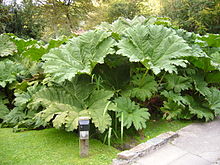Gunnera manicata
| Gunnera manicata | |
|---|---|

| |
| Scientific classification | |
| Kingdom: | Plantae |
| Clade: | Tracheophytes |
| Clade: | Angiosperms |
| Clade: | Eudicots |
| Order: | Gunnerales |
| Family: | Gunneraceae |
| Genus: | Gunnera |
| Species: | G. manicata
|
| Binomial name | |
| Gunnera manicata | |
Gunnera manicata, known as Brazilian giant-rhubarb[1] or giant rhubarb,[2] is a species of flowering plant in the family Gunneraceae from Brazil.[3][4]

It is a large, clump-forming herbaceous perennial growing to 2.5 m (8 ft) tall by 4 m (13 ft) or more. The leaves of G. manicata grow to an impressive size. Leaves with diameters well in excess of 120 cm (4 ft) are commonplace, with a spread of 3 m × 3 m (10 ft × 10 ft) on a mature plant. The underside of the leaf and the whole stalk have spikes on them. In early summer it bears tiny red-green flowers in conical branched panicles, followed by small, spherical fruit. However, it is primarily cultivated for its massive leaves.[4]
This plant grows best in damp conditions such as near garden ponds, but dislikes winter cold and wet.
It has gained the Royal Horticultural Society's Award of Garden Merit.[5]
Despite the common name "giant rhubarb", this plant is not closely related to true rhubarb. It was named after a Norwegian bishop and naturalist Johan Ernst Gunnerus, who also named and published a description about the basking shark.[citation needed]
It is native to the Serra do Mar mountains of Brazil, where it is used in traditional medicine for sexually transmitted diseases.[6]
References[]
- ^ BSBI List 2007 (xls). Botanical Society of Britain and Ireland. Archived from the original (xls) on 2015-06-26. Retrieved 2014-10-17.
- ^ "Gunnera manicata". Natural Resources Conservation Service PLANTS Database. USDA. Retrieved 6 January 2016.
- ^ Wanntorp, Livia; Wanntorp, Hans-Erik; Källersjö, Mari (2002-08-01). "The identity of Gunnera manicata Linden ex André - resolving a Brazilian-Colombian enigma". Taxon. 51 (3): 493–497.
- ^ Jump up to: a b RHS A-Z encyclopedia of garden plants. United Kingdom: Dorling Kindersley. 2008. p. 1136. ISBN 1405332964.
- ^ "Gunnera manicata AGM". RHS Plant Finder. Royal Horticultural Society. Retrieved 27 July 2013.
- ^ Mariotti, Kristiane de Cássia; Schuh, Roselena Silvestri; Matos Nunes, Jéssica de; Salamoni, Sabrina Pinto; Meirelles, Gabriela; Barreto, Fabiano; Von Poser, Gilsane Lino; Singer, Rodrigo Bustos; Dallegrave, Eliane; Van Der Sand, Sueli Teresinha; Limberger, Renata Pereira (Jan 2014). "Chemical constituents and pharmacological profile of Gunnera manicata L. extracts". Brazilian Journal of Pharmaceutical Sciences. 50 (1). Retrieved 20 December 2016.
External links[]
- Pink, A. (2004). Gardening for the Million. Project Gutenberg Literary Archive Foundation.
- Gunnera manicata
| Wikimedia Commons has media related to Gunnera manicata. |
- Gunnera
- Flora of Brazil
- Plants described in 1867